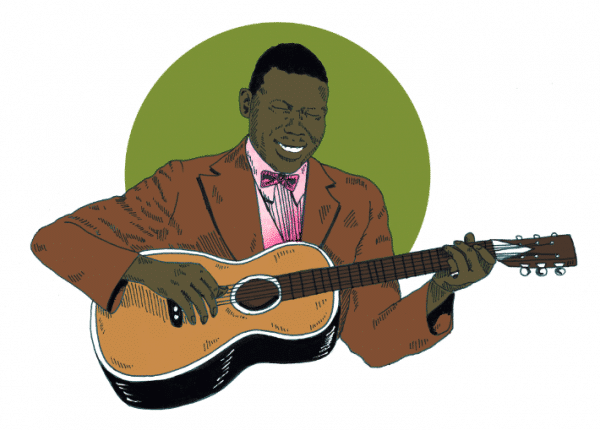
This article appears in the May/June 2015 “Blues Issue.”
Videos by American Songwriter
Guitar-playing blues singers of the 1920s and 1930s had a lot in common, as so many played slide guitar, and often played in open E or open G (sometimes called “Spanish”) tuning. Many were great but were coming from the same place.
And then there was Arthur “Blind” Blake.
Nobody’s 100 percent sure of when Blind Blake was born or exactly where either, but Newport News, Virginia seems to be the best guess. There’s only one photo of him that’s known to exist, and nobody can tell from the picture what brand of guitar he played. It is believed that he spent many years in the Jacksonville, Florida area. If there’s one thing for sure, it’s that Blind Blake was one of the true guitar innovators of his era.
Blind Blake wasn’t a typical bluesman. Instead of playing slide like Blind Willie Johnson from Texas or the Delta legend Son House, Blake put notes together almost like a ragtime piano player. He was one of the primary practitioners of Piedmont blues, or Piedmont fingerstyle playing, which focused on alternating-thumb bassline patterns with rhythmic figures and single lines on the top strings, while singing something completely different, sometimes at furious tempos. He used double-stops, half-step bends and rarely-heard harmonics, or “chimes.” But songs like “Goodbye Mama Moan” and “Down The Country” showed that he was also acquainted with the less-melodic Delta blues form, and was no stranger to the use of the dominant 7th chord.
Blake recorded for the legendary “race records” label Paramount Records in Wisconsin, and cut dozens of sides there, including what may be his best known piece, the six-verse “Diddie Wah Diddie.” The first two verses:
There’s a great big mystery, and it sure is worryin’ me
This diddie wah diddie, this diddie wah diddie
I wish somebody would tell me what
diddie wah diddie means
Had a little girl about four feet four. “C’mon papa and give me some more
of your diddie wah diddie, your diddie wah diddie”
I wish somebody would tell me what
diddie wah diddie means
It’s probably not really all that much of a mystery, though. Since so much of the blues dealt with sex and sexual innuendo, it’s highly probable that “Diddie Wah Diddie” has something to do with that same subject. “Diddie Wah Diddie,” “Police Dog Blues,” “Righteous Blues” and other Blind Blake songs were recently included by Jack White in Third Man Records’ ambitious re-packaging of the Paramount Records catalog, The Rise And Fall Of Paramount Records 1917-1932. “Diddie Wah Diddie” should not be confused with the song “Diddy Wah Diddy” that was later written by Willie Dixon and Bo Diddley, or the Manfred Mann pop hit “Do Wah Diddy Diddy.”
Acoustic guitar scholar and teacher Stefan Grossman is one of the foremost authorities on the music of Blind Blake, as well as the music of many of the guitar players of Blake’s era. “Blake played what you would call ragtime blues,” Grossman says, “and [Piedmont blues legend] Reverend Gary Davis would say that he had a ‘sportin’ right hand.’ Blake was mostly playing out of first position chords, so there was nothing particularly complicated about his left hand. It was all in his syncopation and that’s all in his right hand, how he was picking. He was different from everyone else. No one could really imitate him. When this new dance craze the Charleston came along, Blake was able to put that onto his guitar, [and he] started to ‘stumble’ the bass. Blake also recorded quite a bit with other musicians, and with some of the female singers of that era.”
A lot of Blake’s material revolved around the same subject that most other bluesmen sang about, namely, having the blues because of a woman. “Doggin’ Me Mama Blues,” “Blake’s Worried Blues,” “Low Down Loving Gal” – it seems like a lot of women did him wrong. But when he was singing about them, he somehow managed to play with a technique that was almost totally removed from the vocal and technically a lot more advanced than most of his peers.
Ry Cooder and Leon Redbone both covered “Diddie Wah Diddie” in the 1970s when Blake’s music enjoyed a brief resurgence – as much as was possible, anyway, given the scarcity of old 78s – after counterculture cartoonist R. Crumb introduced “Diddie Wah Diddie” to the turned-on flower child generation. When a woman on Crumb’s cover of the 1968 inaugural issue of Zap Comix said, “I wish somebody would tell me what ‘Diddy-Wah-Diddy’ [sic] means,” Crumb’s soon-to-be-iconic character Mr. Natural replied, “If you don’t know by now, lady, don’t mess with it!”
